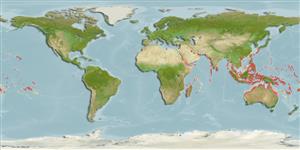Common names from other countries
Environment: milieu / climate zone / depth range / distribution range
البيئة
بحري; مياه مخلوطة مرتبطة بالشعاب; نطاق العمق 0 - 5 m (Ref. 9710), usually 0 - 1 m (Ref. 9710). Tropical; 32°N - 32°S
Indo-Pacific: Red Sea and East Africa to the Line, Marquesan, and Tuamoto islands, north to southern Japan, south to Lord Howe and Rapa.
الحجم / وزن / العمر
Maturity: Lm ? range ? - ? cm
Max length : 16.0 cm TL ذكر/ مختلط الجنس; (Ref. 48636); 13.2 cm SL (female)
الأشواك الظهرية (المجموع) : 12 - 13; الأشعة الظهرية الناعمة (المجموع) : 19 - 21; شوكة شرجية: 2; أشعه شرجية لينه: 21 - 23. Males darkly dusky with 5-6 pairs of bands on body and pale stripes on dorsal fin; develop a crest. Females paler in color, bands broken into spots posteriorly, dorsal fin spotted (Ref. 4404).
Facultative air-breathing (Ref. 126274); Intertidal (Ref. 31184, 48636). Adults are common in areas with large rubble pieces which are often used to built breakwaters or to support jetty-pylons (Ref. 48636). They hide in cracks or holes when not feeding. They jump out of the water in energetic skippings to another pool when pursued (Ref. 2158, 48636). May remain out of water under rocks or seaweeds (Ref. 31184). They breathe air when out of water (Ref. 31184). Feeds on filamentous algae (Ref. 89972). Oviparous. Eggs are demersal and adhesive (Ref. 205), and are attached to the substrate via a filamentous, adhesive pad or pedestal (Ref. 94114). Larvae are planktonic, often found in shallow, coastal waters (Ref. 94114).
Life cycle and mating behavior
Maturities | التكاثر | Spawnings | Egg(s) | Fecundities | Larvae
Distinct pairing (Ref. 205).
Springer, V.G. and J.T. Williams, 1994. The Indo-West Pacific blenniid fish genus Istiblennius reappraised: a revision of Istiblennius, Blenniella, and Paralticus, new genus. Smithson. Contrib. Zool. 565:1-193. (Ref. 9962)
IUCN Red List Status (Ref. 130435)
CITES (Ref. 128078)
Not Evaluated
استخدامات بشرية
مصائد: غير ذات اهمية; حوض مائي: تجاري
أدوات
تقارير خاصة
Download XML
مصادر علي الأنترنت
Estimates based on models
Preferred temperature (Ref.
115969): 24.7 - 29.3, mean 28.4 (based on 2954 cells).
Phylogenetic diversity index (Ref.
82804): PD
50 = 0.5001 [Uniqueness, from 0.5 = low to 2.0 = high].
Bayesian length-weight: a=0.00741 (0.00335 - 0.01640), b=3.02 (2.83 - 3.21), in cm Total Length, based on LWR estimates for this (Sub)family-body shape (Ref.
93245).
مستوى غذائي (Ref.
69278): 2.0 ±0.00 se; based on food items.
المرونه (Ref.
120179): عالي, الحد الزمني الأدني لتضاعف عدد أفراد المجتمع أقل من 15 شهر (Preliminary K or Fecundity.).
Fishing Vulnerability (Ref.
59153): Low vulnerability (10 of 100).
